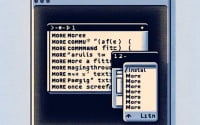Using Chmod Executable | A Unix File Permissions Tutorial

In Unix/Linux environments at IOFLOOD, making a file executable using chmod is a fundamental task for running scripts and programs. In this article, we’ll explore the steps and commands required to make a file executable using chmod, to assist our dedicated cloud hosting customers and fellow developers in effectively managing file permissions.
This guide will walk you through the process of using chmod to change file permissions, from basic use to advanced techniques. We’ll cover everything from the basics of the chmod command, its syntax, and usage, to more advanced techniques, as well as alternative approaches.
So, let’s dive in and start mastering chmod executable in Unix!
TL;DR: How Do I Make a File Executable Using Chmod?
To make a file executable using chmod, you use the chmod command followed by ‘+x’ and the file name. For instance, if you want to make a file named ‘myfile.sh’ executable, you would use the following command:
chmod +x myfile.sh.
Here’s a simple example:
chmod +x myfile.sh
ls -l myfile.sh
# Output:
# -rwxr-xr-x 1 user group size date myfile.sh
In this example, we use the chmod +x command to make ‘myfile.sh’ executable. The ls -l command is then used to display the file permissions, showing that ‘myfile.sh’ is now executable (as indicated by the ‘x’ in the permissions).
This is a basic way to make a file executable using chmod, but there’s much more to learn about file permissions and chmod. Continue reading for more detailed information and advanced usage scenarios.
Table of Contents
The Basics of Executable Files
Let’s start with the basics. The chmod command in Unix is used to change the permissions of a file or directory. The name ‘chmod’ stands for ‘change mode’, and it allows the user to set the read (r), write (w), and execute (x) permissions.
When you want to make a file executable, you use the ‘chmod’ command followed by ‘+x’. The ‘+x’ signifies that you are adding (‘+’) the execute permission (‘x’).
Here’s an example:
chmod +x beginnerfile.sh
ls -l beginnerfile.sh
# Output:
# -rwxr-xr-x 1 user group size date beginnerfile.sh
In this example, ‘beginnerfile.sh’ is the file that we are making executable. After running the chmod command, we use the ls -l command to display the file permissions. The ‘x’ in the permissions shows that ‘beginnerfile.sh’ is now executable.
The advantage of using chmod to make a file executable is that it’s a quick and straightforward way to change file permissions. However, it’s important to be aware of potential pitfalls. For instance, if you use chmod with sudo (as in sudo chmod +x beginnerfile.sh), you can change the permissions of system files, which can potentially lead to system instability if you’re not careful. Always make sure you know what file you’re changing and what the consequences might be.
Further Use: Chmod and User Groups
As you become more comfortable with chmod, it’s time to explore its more advanced uses. One such use is changing permissions for different user groups. In Unix, each file is associated with a user group, and you can set different permissions for the owner, the group, and others.
The chmod command uses a numerical system for setting permissions. The numbers 4, 2, and 1 represent read (r), write (w), and execute (x) permissions, respectively. The sum of these numbers gives you the permission level. For instance, 7 (4+2+1) gives all permissions, and 5 (4+0+1) gives read and execute permissions.
Here’s an example:
chmod 754 intermediatefile.sh
ls -l intermediatefile.sh
# Output:
# -rwxr-xr-- 1 user group size date intermediatefile.sh
In this example, we’re giving the owner full permissions (7), the group read and execute permissions (5), and others only read permission (4). The ‘intermediatefile.sh’ file is now executable by the owner and the group, but others can only read it.
This level of control can be incredibly useful in a collaborative environment, where you might want different users to have different levels of access to a file. But be cautious: incorrectly setting permissions can lead to security vulnerabilities. Always double-check your permission levels and ensure they’re appropriate for the file and its users.
Exploring Alternatives: Beyond Chmod
While chmod is a powerful tool for managing file permissions, it’s not the only game in town. There are alternative approaches to changing file permissions, one of which is using the chown command. The chown command changes the owner of a file or directory.
Here’s an example of how you can use chown:
sudo chown newuser expertfile.sh
ls -l expertfile.sh
# Output:
# -rw-r--r-- 1 newuser group size date expertfile.sh
In this example, we’re changing the owner of ‘expertfile.sh’ to ‘newuser’. Note that we’re using sudo because changing the owner of a file is a system operation that requires administrative privileges. After running the chown command, we use the ls -l command to display the file’s details, showing that ‘newuser’ is now the owner of ‘expertfile.sh’.
The benefit of using chown is that it allows you to change the owner of a file, which can be useful in a multi-user environment. However, the drawback is that it requires administrative privileges, so it’s not something that a regular user can do. It’s also a more drastic measure than using chmod, as it changes the file’s ownership rather than just its permissions.
So, how do you decide between chmod and chown? It depends on your specific needs. If you just need to make a file executable, chmod is the way to go. But if you need to change the owner of a file, chown is your tool. Always consider the implications of changing file permissions and ownership, and choose the tool that best fits your situation.
Best Practices and Chmod Tips
Working with file permissions can sometimes lead to unexpected results. Here are some common issues you might encounter when using chmod to make a file executable, along with their solutions.
Permissions Don’t Seem to Change
You’ve run the chmod command, but when you check the file’s permissions, they don’t seem to have changed. This can happen if you’re not the owner of the file. As a regular user, you can only change permissions for files that you own.
Here’s an example of this issue:
ls -l troublefile.sh
chmod +x troublefile.sh
ls -l troublefile.sh
# Output:
# -rw-r--r-- 1 root group size date troublefile.sh
# -rw-r--r-- 1 root group size date troublefile.sh
In this example, ‘troublefile.sh’ is owned by ‘root’. As a regular user, when you try to make ‘troublefile.sh’ executable, the permissions don’t change.
The solution to this issue is to either become the owner of the file (using chown, as discussed in the previous section) or to have the owner or the system administrator make the file executable.
File Still Not Executable After Changing Permissions
You’ve made a file executable using chmod, but when you try to execute it, you get a ‘Permission denied’ error. This can happen if the file system is mounted with the ‘noexec’ option, which prevents execution of binaries.
The solution to this issue is to remount the file system without the ‘noexec’ option, or to move the file to a different file system that allows execution of binaries.
Remember, changing file permissions and ownership is a powerful operation that can have wide-ranging effects. Always double-check your commands and their potential impact, and follow best practices for file permission management. Keep your files secure by granting only necessary permissions, and always keep backups of important files before making significant changes.
Unix File Permissions Explained
To fully understand the chmod command and its role in making a file executable, it’s essential to grasp the concept of Unix file permissions.
Every file and directory on your Unix system is assigned three types of owner permissions: read (r), write (w), and execute (x). These permissions regulate the level of access users have to a file or directory.
Here’s an example of how file permissions are displayed:
ls -l fundamentals.sh
# Output:
# -rw-r--r-- 1 user group size date fundamentals.sh
In this example, ‘fundamentals.sh’ has read and write permissions for the owner (‘rw-‘), read permissions for the group (‘r–‘), and read permissions for others (‘r–‘).
The first character in the permissions string indicates the file type (‘-‘ for regular files, ‘d’ for directories). The next three characters represent the owner’s permissions, followed by three characters for the group’s permissions, and finally, three characters for others’ permissions.
Understanding these permissions is crucial for using chmod effectively. When you make a file executable using chmod +x, you’re adding execute permissions to the file for the owner, the group, and others. If you want to be more specific, you can use chmod u+x to add execute permissions for only the owner, chmod g+x for the group, and chmod o+x for others.
By understanding the fundamentals of Unix file permissions, you can use chmod to precisely control access to your files and directories, ensuring the right level of security and functionality for your Unix system.
Practical Usages of Chmod
As your experience grows, you’ll find that the chmod command isn’t just about making individual files executable. It plays a crucial role in larger scripts and projects, where you might need to change permissions for multiple files at once.
For instance, you might have a script that generates output files, and you need these files to be executable. You can use chmod within the script to automatically set the correct permissions.
Here’s an example:
#!/bin/bash
echo '#!/bin/bash
echo Hello, World!' > script.sh
chmod +x script.sh
./script.sh
# Output:
# Hello, World!
In this example, we’re creating a script that generates another script (‘script.sh’) and makes it executable. We then run ‘script.sh’, and it prints ‘Hello, World!’.
This demonstrates how chmod can be used within larger scripts to manage file permissions dynamically.
Expanding Your Knowledge: File Ownership, File Groups, and More
Beyond chmod, there are many related concepts that are worth exploring. File ownership and file groups, for instance, are integral to understanding Unix file permissions. The chown and chgrp commands, which change file ownership and group, respectively, are as crucial as chmod.
Further Resources for Mastering Unix File Permissions
If you want to delve deeper into Unix file permissions and related topics, here are some resources to help you on your journey:
- Mastering User and Permission Management – Enhance your Linux security by mastering user and permission management techniques.
How to Use Unix and Linux File Permissions – Learn how to effectively manage file permissions in Unix and Linux systems with this practical guide.
Linux File Permissions Explained: A tutorial by DigitalOcean that covers the basics of Linux file permissions and how to use the umask command.
These resources should give you a solid foundation for mastering file permissions in Unix and using commands like chmod effectively.
Recap: Executable Files & chmod
In this comprehensive guide, we’ve navigated the world of Unix file permissions, focusing on the chmod command and its role in making files executable.
We began with the basics, learning how to use chmod to make a file executable. We then delved into more advanced techniques, such as using chmod to set permissions for different user groups. We also explored alternative approaches, including the chown command for changing file ownership.
Along the way, we addressed common issues that you might encounter when using chmod, such as permissions not changing or files remaining non-executable despite changing permissions. We provided solutions to these issues, helping you troubleshoot chmod effectively.
We also compared chmod with chown, giving you a sense of the broader landscape of file permission and ownership tools in Unix. Here’s a quick comparison of these methods:
| Method | Purpose | Pros | Cons |
|---|---|---|---|
| chmod | Change file permissions | Quick, straightforward | Limited to files you own |
| chown | Change file ownership | Changes owner, not just permissions | Requires administrative privileges |
Whether you’re just starting out with chmod or you’re looking to deepen your understanding, we hope this guide has equipped you with the knowledge to manage Unix file permissions effectively.
Understanding and managing file permissions is a crucial skill in Unix. With the chmod command and its alternatives, you’re well-prepared to ensure the right level of access for your files. Happy coding!


